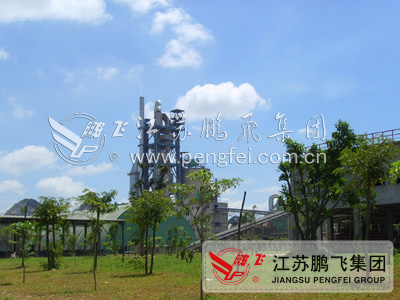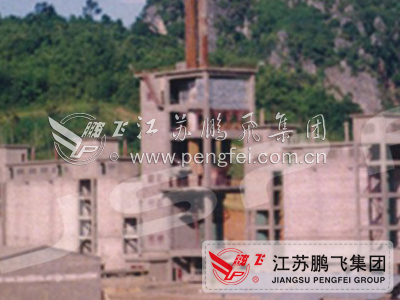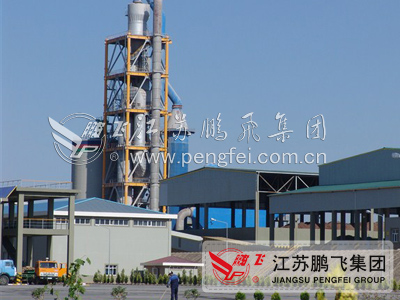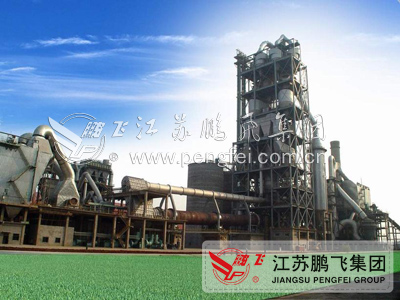A cement production line is a construction project consisting of a series of supporting equipment for producing cement. It mainly consists of crushing equipment, homogenization equipment, raw material preparation equipment, drying equipment, preheating and decomposition equipment, clinker burning equipment, cooling equipment, grinding equipment, packaging equipment, conveying equipment, environmental dust collection equipment, etc. Jiangsu Pengfei Group provides process design, civil construction, complete equipment, installation and commissioning, technical services, and engineering general contracting for cement production lines. A cement production line is a construction project consisting of a series of supporting equipment for producing cement. It mainly consists of crushing equipment, homogenization equipment, raw material preparation equipment, drying equipment, preheating and decomposition equipment, clinker burning equipment, cooling equipment, grinding equipment, packaging equipment, conveying equipment, environmental dust collection equipment, etc. Jiangsu Pengfei Group provides process design, civil construction, complete equipment, installation and commissioning, technical services, and engineering general contracting for cement production lines. A cement production line is a construction project consisting of a series of supporting equipment for producing cement. It mainly consists of crushing equipment, homogenization equipment, raw material preparation equipment, drying equipment, preheating and decomposition equipment, clinker burning equipment, cooling equipment, grinding equipment, packaging equipment, conveying equipment, environmental dust collection equipment, etc. Jiangsu Pengfei Group provides process design, civil construction, complete equipment, installation and commissioning, technical services, and engineering general contracting for cement production lines.
Process parameters
In the process of cement production line, for every 1 ton of Portland cement produced, 3 tons of materials (including various raw materials, fuels, clinker, mixtures, and gypsum) need to be ground. According to statistics, the power consumption of the dry cement production line grinding operation accounts for more than 60% of the total power consumption of the plant, of which raw material grinding accounts for more than 30%, coal grinding accounts for about 3%, and cement grinding accounts for about 40%. Therefore, reasonable selection of grinding equipment and process flow, optimization of process parameters, correct operation, and control of operating systems are of great significance for ensuring product quality and reducing energy consumption.
Production method
Cement production mainly uses limestone and clay as raw materials, which are crushed, proportioned, and vertically ground into raw materials. Then, they are fed into a cement rotary kiln to calcine the mature materials. The clinker is added with an appropriate amount of gypsum, mixed with some mixed materials or additives, and ground into cement by a roller press and cement mill. Finally, it is transported out of the factory by a packaging machine or bulk machine. Cement production equipment can be divided into two types: dry cement production lines and wet cement production lines, depending on the method of raw material preparation. (1) Dry process cement production process flow. The method of simultaneously drying and grinding raw materials, or first drying and grinding them into raw material powder, and then feeding them into a dry rotary kiln for calcination into clinker. There is also a method of adding an appropriate amount of water to the raw material powder to make raw material balls, which are then sent to the Libol kiln for calcination into clinker, called semi dry method, which is still one of the dry production methods. The main advantage of dry production is low heat consumption. The heat consumption of clinker in dry kilns with preheaters is 3140-3768 coke/kg. The disadvantage is that the raw material composition is not easily uniform, the workshop has high dust emissions, and the power consumption is high. (2) Wet cement production process flow. The method of grinding raw materials into slurry by adding water powder and feeding them into a wet rotary kiln to calcine mature materials. There is also a method of dehydrating the raw material slurry prepared by wet method and making raw material blocks into kiln calcined mature materials, called semi wet method, which is still one of the wet production methods. Wet production has the advantages of simple operation, easy control of raw material composition, good product quality, convenient slurry transportation, and less dust in the workshop. The disadvantage is high heat consumption, with clinker heat consumption usually ranging from 5234 to 6490 coke/kg.
The device includes
The main equipment of the cement production line includes: cement rotary kiln, cyclone preheater, cooler, crusher, vertical mill, roller press, cement mill, coal mill, dryer, dust collector, packaging machine, bulk loader, conveyor, electrical control, etc.
Process flow
1. The limestone crushing dump truck pours the limestone into the hopper, and after being crushed by a hammer crusher, it is transported by a belt conveyor to the limestone pre homogenization yard. The cantilever stacker is used for layered stacking and material retrieval. The extracted limestone is transported by a belt conveyor to the limestone batching bin at the raw material batching station. An electromagnetic iron remover is installed on the incoming belt conveyor to remove potential iron components from limestone. A metal detector is installed at the head of the belt conveyor to detect any remaining iron parts in the raw materials, in order to prevent damage to the raw material grinding roller press. The raw material batching station is equipped with four batching warehouses for limestone, silica, iron ore tailings, and wet fly ash. Each ingredient bin is equipped with a plate feeder and a quantitative feeder at the bottom. The four types of raw materials are discharged by their respective quantitative feeders according to the required proportion of ingredients, and the mixed materials are fed into the small bin of the raw material grinding roller press through a belt conveyor.
2. The raw material grinding adopts a roller press and a discharge grinding system with a diameter of 4.6m × (10+3.5) m, using the high-temperature exhaust gas discharged from the kiln tail as the drying heat source. After being squeezed by a roller press, the material is dried and classified by a V-shaped powder selector. The fine powder is selected by an efficient powder selector, and a portion of the fine powder is sent to the raw material homogenization warehouse through an air conveying chute and a bucket elevator. Another portion of coarse powder and wet fly ash is fed into the raw material for grinding and milling. The materials are ground and dried in the raw material mill, and the raw materials from the mill enter the powder selection machine through the elevator. After powder selection, the coarse powder returns to the mill, and the fine powder is sent to the raw material homogenization warehouse through the air conveying chute and bucket elevator. After passing through the powder selection machine, the waste gas from the grinding process enters the waste gas treatment workshop and is purified by the electrostatic precipitator before being discharged into the atmosphere. The exhaust gas from the grinding process is purified by an electrostatic precipitator and discharged into the atmosphere.
3. The coal mill is located at the kiln tail, and a portion of the kiln tail exhaust gas is collected by a cyclone dust collector and used as a drying heat source for raw coal. After the kiln tail exhaust gas is humidified and cooled by the humidification tower, it directly enters the kiln tail electric dust collector. The amount of water sprayed by the humidification tower is automatically controlled according to the outlet exhaust gas temperature of the humidification tower, so that the exhaust gas temperature is within the allowable range of the kiln tail electric dust collector. The purified exhaust gas from the dust collector is discharged into the atmosphere by the exhaust fan. The kiln ash collected by the humidification tower is transported by conveying equipment to the kiln feeding system or raw material homogenization silo. Set up a continuous raw material homogenization silo with a diameter of 18m. The raw materials in the silo are aerated in alternating zones and discharged from the surrounding annular zone to the mixing chamber. The raw materials are aerated and stirred evenly in the mixing chamber. The required bottom inflation is supplied by the configured Roots blower. After homogenization, the raw material powder is metered and then fed into the two feed ports of the dual series preheater through an air conveying chute and a bucket elevator, and then through a distribution valve and a lock valve.
4. The firing workshop consists of a five stage dual series suspension preheater, decomposition furnace, rotary kiln, grate cooler, and corresponding dust removal system, with a daily output of 3000 tons of clinker. The raw materials fed into the preheater are preheated by the preheater and decomposed in the decomposition furnace before being fed into the kiln for calcination; The high-temperature clinker discharged from the kiln is cooled in the grate cooler. The large clinker is crushed by the crusher and then combined with the small clinker leaked to the air chamber, and sent to the clinker storage by the clinker chain bucket conveyor. The hot air from the clinker bed not only provides high-temperature secondary and tertiary air to the kiln and decomposition furnace respectively, but also purifies the exhaust gas through an electrostatic precipitator and discharges it into the atmosphere through an exhaust fan. After the clinker is unloaded by the bottom unloading device of the warehouse, it is transported to the bulk truck station by a belt conveyor. The bulk clinker is directly loaded onto the truck through dust-free bulk heads located at the bottom of each warehouse.
5. The coal powder preparation adopts a vertical grinding system, which uses the high-temperature exhaust gas discharged from the kiln tail as the drying heat source. The raw coal is fed into the coal mill by a quantitative feeder under the raw coal bin for drying and grinding. The ground coal powder enters the bag filter with the airflow, and the qualified coal powder is collected and sent to the coal powder bin with a load sensor by a screw conveyor. After being measured, the coal powder is sent to the burner at the kiln head and the decomposition furnace at the kiln tail for combustion. The dusty gas is purified by an anti-static bag dust collector and discharged into the atmosphere through an exhaust fan. Both the coal powder silo and bag filter are equipped with CO detector devices and explosion-proof valves. A central laboratory is established throughout the factory, responsible for the inspection of raw materials, semi-finished products, and finished products; And set up an air compressor station to supply compressed air for the entire factory's production.
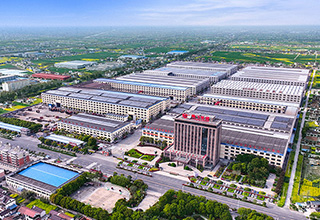
 Real time updates on cutting-edge information, presenting Pengfei and industry trends in a timely, comprehensive, and intuitive manner.
Real time updates on cutting-edge information, presenting Pengfei and industry trends in a timely, comprehensive, and intuitive manner.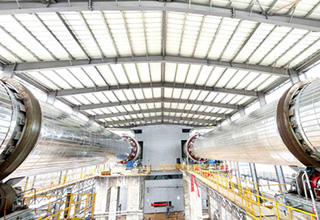
 We firmly believe that talent is the foundation of enterprise development. We adhere to the talent concept of "people-oriented, co creation and win-win", respect the personality and creativity of each employee, and are committed to providing employees with broad development space and a fair competitive platform.
We firmly believe that talent is the foundation of enterprise development. We adhere to the talent concept of "people-oriented, co creation and win-win", respect the personality and creativity of each employee, and are committed to providing employees with broad development space and a fair competitive platform.
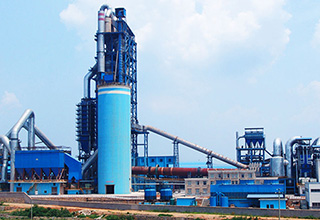

 中文
中文 English
English
